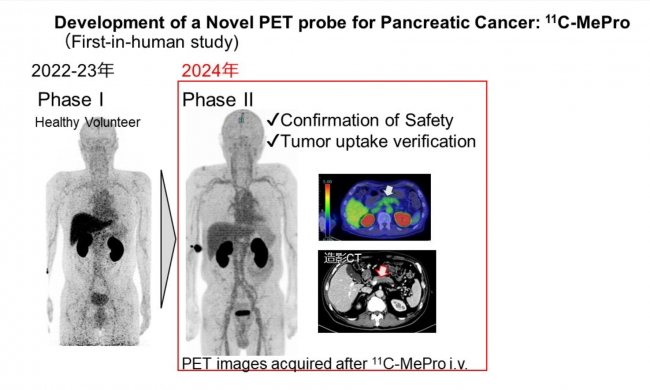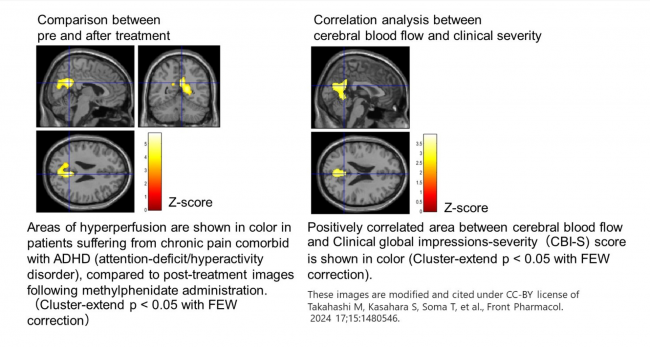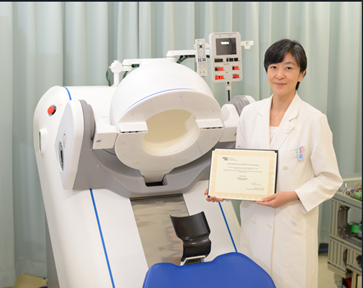Our group has been conducting a variety of clinical studies to verify the utility and enhance the practical value of new radiopharmaceuticals and imaging systems developed by QST.
Nuclear medicine is a scientific field that effectively utilize the energy emitted from atomic nuclear to investigate the mechanisms of organ function or disease. This distinctive strength enables us to collaborate closely with researches and medical professionals across wide range of specialized field, both within and beyond QST.
PET Imaging Clinical Study Using a Promising Radiopharmaceuticals for Diagnosis
A clinical study is currently being conducted using a novel PET probe, 11C-MePro, for the diagnosis of pancreatic cancer. While 18F-FDG has been widely used for cancer imaging, it has limitations in distinguishing malignant tumors from pancreatitis or benign lesions. If the utility of this new PET probe is validated through our study, it could significantly improve the accuracy of pancreatic cancer diagnosis.

Neurofunctional Study of Chronic Pain with Comorbid+ Attention-Deficit/Hyperactivity Disorder (ADHD)
We have investigated brain function alterations in patients suffering from chronic pain with comorbid attention-deficit/hyperactivity disorder (ADHD). This work is collaboration with Dr. Kasahara, a psychiatrist in the Department of Anesthesiology and Pain Relief Center at the University of Tokyo Hospital.
Our findings revealed relative hyperperfusion in the posterior cingulate cortex and precuneus, as demonstrated by comparing cerebral blood flow SPECT images before and after treatment. We are now conducting further investigations to clarify the specificity of these findings, with the aim of supporting accurate diagnosis and guiding appropriate medication choices (This work is supported by JSPS KAKANHI Grant Numbers JP 24K13083).

Clinical Studies of Novel Nuclear Medicine Imaging systems
- Brain-dedicated PET
We have demonstrated the high performance of the brain-dedicated PET developed by QST. The small neuronal nuclei in such the brain stem or thalamus were visualized, which was not possible with other clinical PET systems. Using this brain-dedicated PET, we are conducting a clinical study with the cooperation of patients suspected to have very early-stage Alzheimer’s disease, aiming to detect detailed alterations in brain function and early β-amyloid deposition.(This work is supported by ATOX CO., TLD. and JSPS KAKANHI Grant Numbers JP23K07148)

(Received the Poster Award at the 2022 Society of Nuclear Medicine and Molecular Imaging (SNMMI) Annual Meeting)
- Development of forceps-type mini-PET
We proposed that if surgeons can identify malignant tumors or metastatic lymph nodes during surgery, they can more precisely resect affected regions while preserving normal tissues. This approach may help reduce surgical complications through less invasive procedures.
To realize this concept, we developed a forceps-type mini-PET, in which compact PET detectors are embedded in the tips of the forceps. This project has been supported by AMED and conducted in collaboration with researchers from Chiba University, surgeons from The University Tokyo Hospital and the National Cancer Center Hospital. Mirai-Imaging Corp. is leading the commercialization efforts.
Development of Nuclear Medicine Therapy (Preclinical studies)
We are collaborating with other research groups at QST to develop radiopharmaceuticals for targeted radionuclide therapy (TRT). Currently, in addition to conducting preclinical studies, we are focusing on overcoming challenges such as tumor heterogeneity and potentially mismatched drug distribution to tumor viable tumor cells. Our research takes into account both the physical characteristics of radiation and its medical properties to address these challenges.
Member

Takahashi Miwako Group leader
- Obara Satoshi Researcher
- Yamasaki Mariko Staff
- Yoshioka Naho Staff
Selected Publications
- Takahashi M.,Nishikido F Akamatsu G.,Tashima H.,Iwao Y.,Suga M.,Yamaya T.:The first human study of add-on PET: A PET-integrated RF coil for 3 T MRI.EJNMMI Phys,12(1),1-19,(2025)
- Takyu S.,Tashima H.,Takahashi M.,Yoshida E.,Wakizaka H.,Obata F.,Akamatsu G.,Nagatsu K.,Sugyo A.,Sudo H.,Tsuji AB.,Ishibashi M.,Imai Y.,Parodi K.,Yamaya T.:A whole gamma imaging prototype for higher quantitative imaging of89Zr-labeled antibodies in a tumor mouse model.Phys Med Biol.,70(2),(2025)
- Kasahara S.,Takahashi M.FSuto T.,Morita T.,Obata H.,Niwa SI.:Innovative therapeutic strategies using ADHD medications tailored to the behavioral characteristics of patients with chronic pain.Frontiers in Pharmacol,16,1500313,(2025)
- Kawamura K.,Nakajima A.,Ito S.,Takahashi M.,Yamaya T.:Radiation source detection for the accurate location of lymph node metastases using robotic forceps-type coincidence radiation detector.Int J Comput Assist Radiol Surg,20(4),677-686,(2025)
- Takahashi M.,Kasahara S.,Soma T.,Morita T.,Sato N.,Matsudaira K.,Niwa SI.,Momose T.:Precuneal hyperperfusion in patients with attention-deficit/hyperactivity disorder-comorbid nociplastic pain.Frontiers in Pharmacolgy,15,1480546,(2024)
- Kasahara S.,Takahashi M.,Takahashi K.,Morita T.,Matsudaira K.,Sato N.,Momose T.,Niwa SI.,Uchida K.:Case Report:Methylphenidate and venlafaxine improved abdominal nociplastic pain in an adult patient with attention deficit hyperactivity disorder,autism spectrum disorder, and comorbid major depression.Frontiers in Pharmacolgy,5,1394131,(2024)
- Yamaya T.,Tashima H.,Takyu S.,Takahashi M.:Whole Gamma Imaging:Challenges and Opportunities. PET Clin,19(1),83-93,(2024)
- Ishibashi M.,Takahashi M.,Yamaya T.,Imai Y.:Current and Future PET Imaging for Multiple Myeloma.Life (Basel),13(8),1701,(2023)
- Kasahara S.,Takahashi M.,Morita T.,Matsudaira K.,Sato N.,Momose T.,Niwa SI.,Uchida K.:Case report: Atomoxetine improves chronic pain with comorbid post-traumatic stress disorder and attention deficit hyperactivity disorder.Frontiers in Pharmacolgy,14,1221694,(2023)
- Takahashi M.,Akamatsu G.,Iwao Y.,Tashima H.,Yoshida E.,Yamaya T.:Small nuclei identification with a hemispherical brain PET.EJNMMI Phys,9(1),69,(2022)
